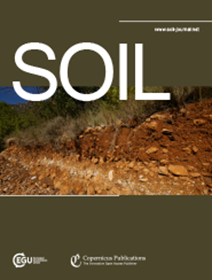Living cover crops reduce pesticide residues in agricultural soil
IF 4.3
2区 农林科学
Q1 SOIL SCIENCE
引用次数: 0
Abstract
Abstract. Living cover crops play a key role in reducing nitrogen leaching to groundwater during fallow periods. They also enhance soil microbial activity through root exudates, improving soil structure and increasing organic matter content. While the degradation of pesticides in soil relies primarily on microbial biodegradation, the extent to which cover crops influence this degradation remains poorly quantified. In this paper we (1) monitored pesticide residue levels in soil and soil solution under two different cover crop densities and (2) correlated the observed reductions with physicochemical properties of the active substances. Our results show that thin cover crops (0.4 tDM ha-1) reduce pesticide leaching 80 days after sowing compared to bare soil, retaining the residues in the microbiologically active topsoil. In addition, well-developed cover crops (1 tDM ha-1) reduce soil pesticide contents by more than 33 % for compounds with low to high water solubility (s ≤ 1400 mg L-1) and low to moderate soil mobility (Koc ≥ 160 mL g-1). This effect is probably due to enhanced pesticide degradation of the retained pesticide in the rhizosphere. These results confirm previous studies on individual compounds, individual cover crop types and individual soil compartments, while providing new thresholds for physicochemical properties associated with significant pesticide degradation. By directly enhancing pesticide degradation within the soil compartment where pesticides are applied, cover crops limit their transfer to other environmental compartments, particularly groundwater.活着的覆盖作物减少了农业土壤中的农药残留
摘要。活的覆盖作物在减少休耕期氮向地下水的淋失中起着关键作用。它们还通过根系分泌物增强土壤微生物活性,改善土壤结构,增加有机质含量。虽然农药在土壤中的降解主要依赖于微生物的生物降解,但覆盖作物对这种降解的影响程度仍然难以量化。本文(1)监测了两种不同覆盖作物密度下土壤和土壤溶液中的农药残留水平,(2)将所观察到的农药残留量与活性物质的理化性质进行了关联。结果表明,与裸地相比,薄盖作物(0.4 tDM ha-1)在播种后80天减少了农药淋失,将农药残留保留在微生物活性表土中。此外,对于低至高水溶性(s≤1400 mg L-1)和低至中等土壤流动性(Koc≥160 mL g-1)的化合物,发育良好的覆盖作物(1 tDM ha-1)可使土壤农药含量降低33%以上。这种效应可能是由于残留农药在根际的降解增强所致。这些结果证实了以往对单个化合物、单个覆盖作物类型和单个土壤区格的研究,同时为农药显著降解相关的理化性质提供了新的阈值。覆盖作物通过直接促进施用农药的土壤隔间内农药的降解,限制了它们向其他环境隔间的转移,特别是地下水。
本文章由计算机程序翻译,如有差异,请以英文原文为准。
求助全文
约1分钟内获得全文
求助全文
来源期刊

Soil
Agricultural and Biological Sciences-Soil Science
CiteScore
10.80
自引率
2.90%
发文量
44
审稿时长
30 weeks
期刊介绍:
SOIL is an international scientific journal dedicated to the publication and discussion of high-quality research in the field of soil system sciences.
SOIL is at the interface between the atmosphere, lithosphere, hydrosphere, and biosphere. SOIL publishes scientific research that contributes to understanding the soil system and its interaction with humans and the entire Earth system. The scope of the journal includes all topics that fall within the study of soil science as a discipline, with an emphasis on studies that integrate soil science with other sciences (hydrology, agronomy, socio-economics, health sciences, atmospheric sciences, etc.).
 求助内容:
求助内容: 应助结果提醒方式:
应助结果提醒方式:


